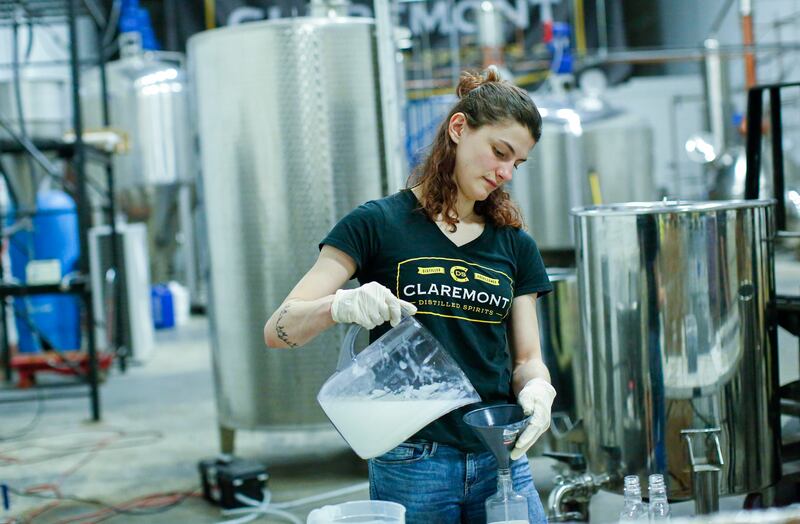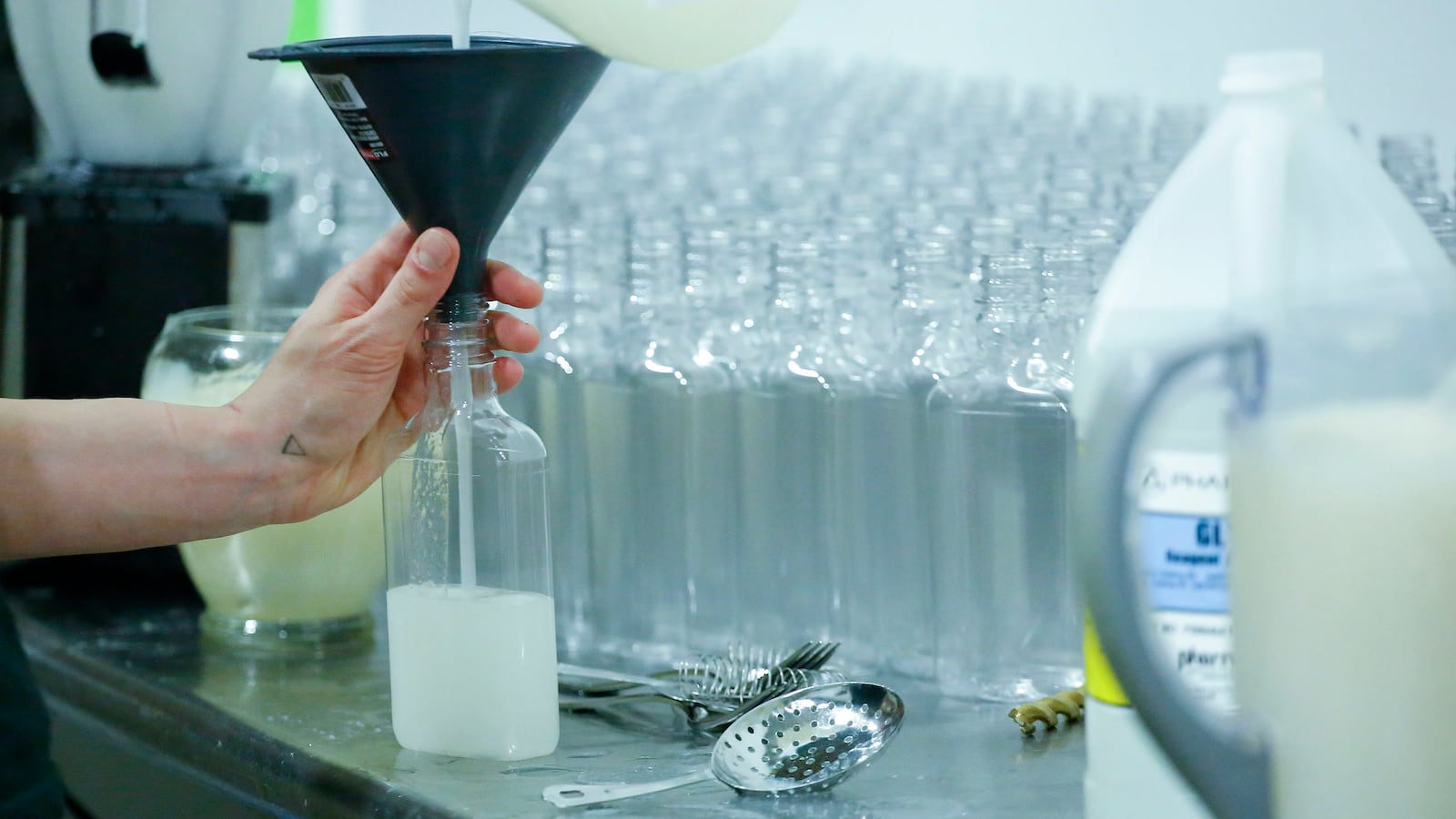“We’re busier here than we’ve ever been,” says Ryan Campbell, co-founder of Desert Door Distillery in Driftwood, Texas. But it’s not their well-regarded sotol from locally harvested desert plants that’s got them running flat out. It’s blending their alcohol with glycerol and hydrogen peroxide in vats, then putting it in plastic bottles and giving it away. “The liquor we use to make this is very expensive,” Campbell says.
Desert Door was among the first wave of hundreds of distillers who swiftly geared up to make hand sanitizer. Being smaller often brings disadvantages in a crowded marketplace, but it does allow many to produce something new virtually overnight.
Sanitizer, as we all now know, is the Maginot Line against coronavirus. A well-applied dose can help prevent transmission from person to person. Soap and water does the same, but is less convenient for maintaining germ-free hands during the day. So, it’s become an essential weapon for first responders, as well those working in hospitals, doctor’s offices, homeless shelters, daycare centers, grocery stores and factories providing other vital services.
On March 13, a national emergency was declared. Sanitizer, already hard to find, became even more scarce owing to a combination of fear, runaway demand and hoarder greed. Not that this is a new phenomenon—shortages also hit the sanitizer industry during the less cataclysmic 2008 outbreak of swine flu.
The difference between 2008 and 2020 is that the number of craft distillers making alcohol has mushroomed, from about 150 to nearly 2,000. And, according to the American Craft Spirits Association, around three-quarters of all distillers are now either producing hand sanitizer or planning to do so. The vast majority of these were providing the sanitizer for free to those who needed it most. And some like Amass in California, which makes an alcohol-based botanic wash, are selling the products to consumers and donating a portion to charity.

The switch in production was at once simple and complicated. Simple because the chief ingredient of both liquor and sanitizer is ethanol. Under guidelines issued by the World Health Organization and the Food and Drug Administration, sanitizer should start with high-proof ethanol—96 percent alcohol by volume, which is then diluted with other products (glycerol, hydrogen peroxide, distilled water) to about 80 percent alcohol.
Distillers who were already geared up to make gin and vodka were, generally, the first out of the gate—they had the column stills and other equipment to efficiently produce high-proof alcohol. (Whiskey and rum generally come off the still at a much lower proof, and producers of those spirits buy equipment accordingly.)
Desert Door is about a half-hour from Austin, and Campbell said that he and his partners revisited their mission almost immediately after South by Southwest canceled its 2020 festival on March 6. Campbell, who is fluent in Korean, had been reading Asian news online about the coronavirus and its spread. He had read reports of shortages of sanitizer overseas. “I saw what was happening there, and how that was likely to impact supply chains here,” he says.
He and his partners did research, located the WHO formula, then filed to have their license amended to produce denatured alcohol (ethanol with an additive that renders it unfit to drink and thus free of high excise taxes). They sourced the other ingredients, blended them and then started up a new automated bottling line.
Their first run of 8,000 eight-ounce bottles went smoothly…right up until they announced its availability. “We were deluged with donation requests,” he says—from police, fire departments, and hospitals, among others. Campbell immediately ordered 12,000 more bottles, and started offering it in different sizes—two ounces for consumers, four ounces and five-gallon plastic buckets for institutional use. To date they’ve supplied about 30 agencies, from Corpus Christi to San Antonio, including 110 gallons to the city of Austin. All of it has been given away.
Many other distillers making hand sanitizer are finding demand is equally strong. Black Dirt Distillery in Orange County, New York, which has an efficient 60-foot column still, produced 50 gallons of hand sanitizer with plans to offer it to first responders and the public. They withdrew their offer to the public within days after realizing they couldn’t even fulfill requests among area health workers.
Maggie Campbell, head distiller and CEO at Privateer Rum in Ipswich, Massachusetts, said she didn’t have any plans to make sanitizer, as it was out of their bailiwick. But after fielding two requests from local hospitals seeking neutral alcohol to make their own, she diverted some of their premium Queen’s Share Rum, which then happened to be in production, from the barrel to the hospitals.
Paul Hletko, founder of FEW Spirits in Illinois and former president of ACSA, said he’s weighing options for producing sanitizer. As a whiskey producer, they aren’t equipped to make high-proof ethanol and he’s been searching for a source for neutral grain spirits, but finding it in short supply. He notes that making sanitizer isn’t as simple as it seems.
“There are people who specialize in this the same way we specialize in making whiskey, and we see what happens when people who don’t know how to make whiskey, make whiskey.” He worries about those making sanitizer that doesn’t work as advertised. “If we release something that says sanitizer but doesn’t sanitize, well, that’s bad.”
Navigating regulations from the TTB, FDA, IRS, and even the EPA (for those making a spray sanitizer) has been somewhat tricky, although distillers are already pretty adept at thorny paperwork. And the feds have moved quickly to temporarily alter or suspend regulations to allow more sanitizer to be made. (FDA: “The agency does not intend to take action against manufacturing firms that prepare alcohol-based hand sanitizers for consumer use and for use as health care personnel hand rub.”) The stimulus bill working its way through Congress last week also included provisions to temporarily halt taxes on alcohol that ends up in sanitizer, making it more economical to produce.

Others distillers have reported the sourcing materials needed for hand sanitizer present a challenge. They’re placing relatively small orders for plastic bottles, caps, labels and the like, as well as industrial chemicals typically delivered by tanker. And some have had issues connecting with suppliers unexpectedly inundated with orders, and with whom they may not have worked before. “We only had trouble sourcing because they are products we don’t normally source,” says Katie Darling, CEO at Celebration Distillation in New Orleans. “But once we found suppliers, it’s just taken a few conversations to place orders.”
Those who launched their sanitizer lines early on appear to have had an easier go of it. “It’s all logistics,” said Markus Kypreos, founder at Blackland Distilling in Fort Worth.
“Some figured it out five or six days ago, and others are just now trying to figure it out.”
Blackland has been making their hand sanitizer for about a week, using distillate they had made from red winter wheat and was being held for gin production. He’s distilling more now, but says it takes eight or nine days from mashing to bottling using his 500-gallon hybrid still. As of this story, he’d made and hand bottled about 600 gallons of sanitizer.
Of that, about 100 gallons have been donated to local first responders. Two-ounce bottles are given away with liquor purchases, and some provided to liquor stores who purchase their products. The rest he’s sold to area residents, with a limit of two eight-ounce bottles per person for $7 each. Even so, this led to lines of cars up to ten blocks long for curbside purchases.
Kypreos says that producing his own winter wheat distillate is an expensive way to make hand sanitizer, and he’s looked at buying neutral grain spirit for sanitizer production. “But there’s nothing out there,” he says. He’s been told that bigger producers and governments are buying it up.
John Wilkinson, a board member at Greenfield Global in Ontario, a major supplier of industrial alcohol, doesn’t dispute that. He says since the outbreak there’s been a tripling of demand for alcohol used in hand sanitizers and industrial disinfectants. They can increase production, he says, since the demand for fuel ethanol has dropped sharply, freeing up production capacity. But the logistics of getting alcohol to those who need it most—and Greenfield has prioritized those “right at the front line of the battle”—has been challenging at times. “What we’re hearing is the people like us are maxed out.”
Wilkinson notes that sales have naturally spiked as customers have rushed to stockpile sanitizer, but also assumes that demand for sanitizer will remain significantly higher in coming months than before coronavirus arrived, as consumer behavior is likely to alter permanently.
“People are getting in the habit of using [sanitizer] now,” he says. “And hotels, subways, hospitals—everybody who disinfects—will be doing more of it because customers will want to be assured that they’re keeping their facilities clean. One of the things coming out of this is a new normal with a bar that’s set higher.”

Still, no craft distiller I spoke with had plans to make craft hand sanitizer over the long run. Larger distillers have announced that they’re getting into the sanitizer game (Tito’s, Bacardi, Heaven Hill, Pernod Ricard, Ron Barcelo, Buffalo Trace), which will go a long way to boosting supplies.
And industrial suppliers will ramp up to meet market demand; lobbying is underway to allow fuel ethanol producers to divert some of their production to sanitizer ethanol. Hand sanitizer is a $2.6 billion global industry (2018), with about a third of those sales in the United States. The industry can’t be expected to pivot swiftly, but with predictions of demand more than doubling, major producers will continue to make adjustments to meet emergency needs.
Hletko at FEW Spirits suspects it will require a 28-day cycle for industry to ramp up to supply demand, “and we’re now seven days into it.” In fairly short order, he expects supplies of both ethanol and sanitizer will catch up with demand.
Until then, more nimble craft distillers seem hellbent to do their part equipping those on the front lines of the fight against the virus.
“I’ve got employees who are having the time of their life,” says Campbell at Desert Door. “First responders are coming in all day long. Our employees know they are part of the solution and not just bystanders.”







